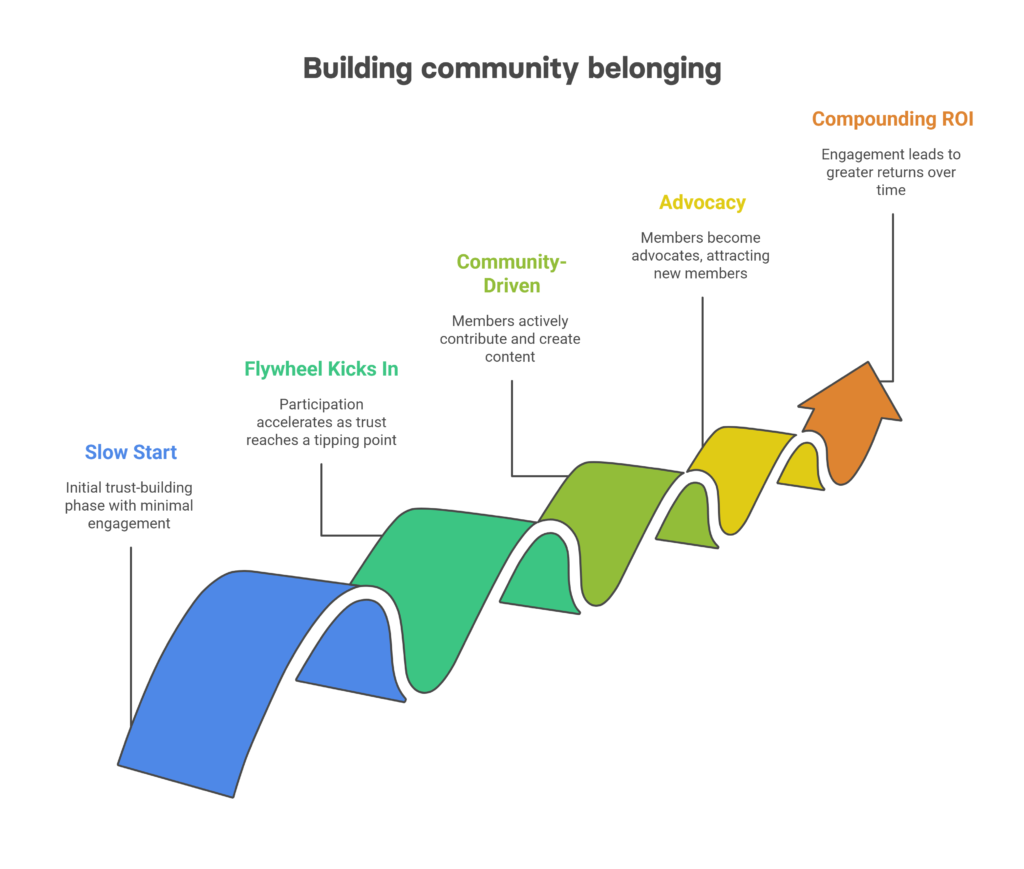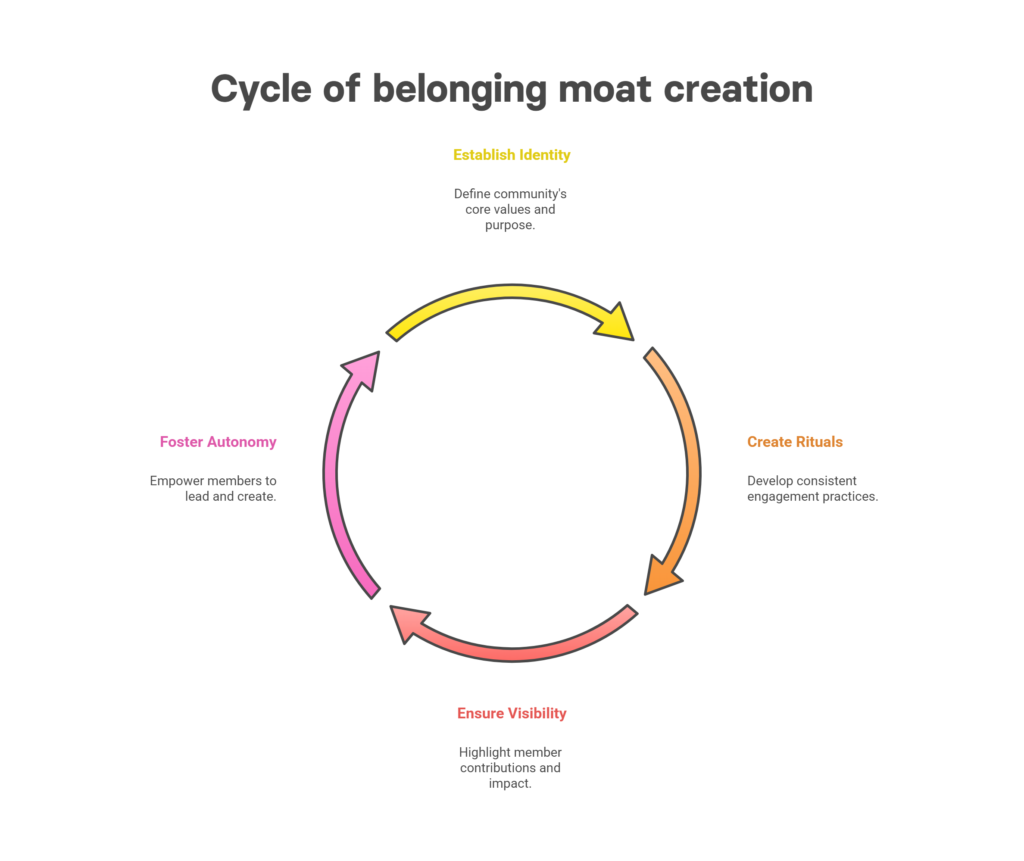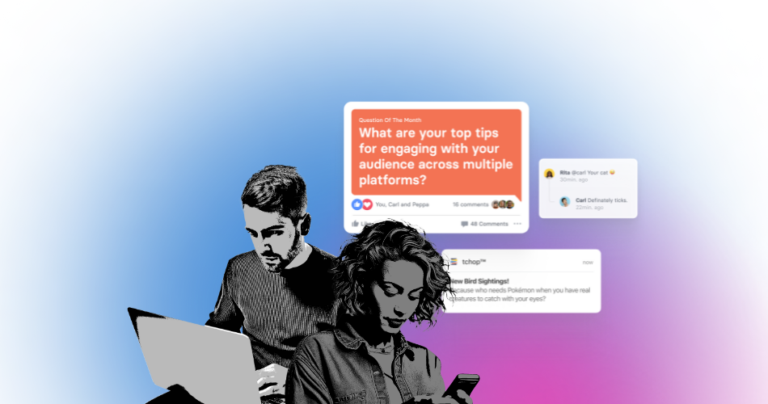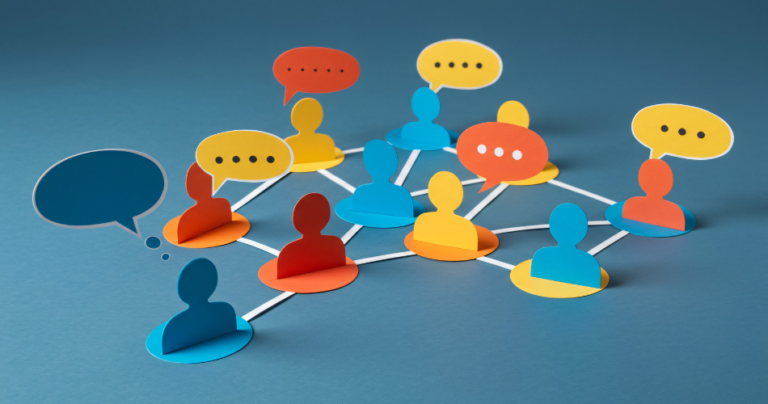Every brand wants to talk about loyalty. It looks great in presentations, sounds solid, feels timeless. But most of what we call brand loyalty today? It’s not really loyalty.
It’s familiarity. The comfort you get from seeing a logo enough times that clicking feels safe. That’s repetition doing its work through ad budgets and algorithms, not any real emotional connection. Here’s what’s actually true: people aren’t loyal to the brands they buy from most often. They’re loyal to the ones that make them feel something.
The numbers tell the story. According to the 2025 Edelman Trust Barometer, people increasingly want personal relevance over broad corporate purpose. Nielsen found something even more striking: 89% of people trust recommendations from someone they know more than any branded message. Think about that gap. The harder brands talk at people, the less those people believe them.
You can feel this shift if you spend any time online. Audiences are exhausted. Influencer fatigue isn’t just a buzzword anymore. Algorithms change overnight and suddenly your entire traffic model collapses. Paid reach keeps costing more while delivering less impact. Still, brands confuse exposure with endurance, like being visible is somehow the same as being valued.
Familiarity can be bought. Loyalty cannot. When visibility becomes unreliable (platforms change rules, consumers tune out, attention splinters into a thousand directions), familiarity fails as protection.
So what’s the real challenge? It’s not awareness. Brands have figured that part out. The challenge is durability. Keeping what you’ve earned when reach stops working. And there’s only one thing that truly protects you: the human element. The kind of belonging no ad budget can manufacture.
If loyalty based on exposure is eroding, what actually protects a brand now? Let’s look at what makes something truly defensible, and why belonging matters more than anything else.
What moats look like now
Business schools love talking about moats. It’s Warren Buffett’s term for what keeps competitors out, the kind of advantage that compounds over time and can’t be easily replicated.
For years, brands built these moats through data and distribution. Own the data, understand your customers better. Control the distribution, reach them faster and cheaper. Trust came next as the emotional layer, the reason people would listen to you when ten other brands were saying the exact same thing.
Then the cracks started showing.
Data became a commodity. Third-party cookies are disappearing. Personalization stopped being special and became the bare minimum people expect. Distribution? That’s mostly rented from platforms that can change the rules on a whim. As for trust, well, we’ve already seen how fragile that’s become. One bad campaign and years of goodwill just vanish.
What’s left to protect you?
Enter what we call the Defensibility Stack, a framework for how brands stay protected when everything else can be copied:
| Layer | Function | Example |
|---|---|---|
| 1. Data | What you know about your audience | Analytics, CRM, first-party signals |
| 2. Distribution | How you reach them | Website, apps, social, ads, SEO |
| 3. Trust | Why they believe you | Brand consistency, experience |
| 4. Belonging | Why they stay and defend you | Community, shared identity |
Notice something about the first three? They’re all built on access and optimization. The fourth layer works differently. Belonging runs on identity.
Here’s what makes it special: belonging is the only moat that actually gets stronger the more it’s used. People participate more, they invest more emotionally. This doesn’t fade like ad recall or engagement rates do. It builds on itself.
Look at Apple. Sure, it’s a product ecosystem, but it’s also become a social signal. The experience of being inside the Apple world creates loyalty that rivals the hardware itself. Or take Spotify Wrapped, which has turned into this annual cultural moment because people don’t just consume it. They’re part of creating it.
What these examples reveal is structural. Belonging doesn’t live in your infrastructure. It lives in people. You can rent distribution, automate trust signals, even outsource your analytics. But identity? That you cannot outsource.
Once you’ve built real belonging, it transforms into something like collective ownership. People start defending your brand. They correct misconceptions about it. They carry its meaning forward even when you’re not actively marketing. That’s defensibility in its purest form, the kind that exists independent of algorithms, budgets, or platform politics.
Every other moat can be disrupted. The only advantage that truly lasts is the one built on human connection.
If belonging sits at the top of this stack now, there’s an obvious next question: what’s the actual economic logic behind it? How does something as intangible as belonging translate into hard business value?
When community becomes capital
Here’s the part that makes executives uncomfortable: belonging sounds soft. Its impact isn’t.
We measure what’s easy. Impressions, clicks, conversions all fit neatly into spreadsheets. But what actually drives long-term brand value is harder to pin down: the emotional commitment that keeps people from switching, their willingness to forgive mistakes, that instinct to recommend you when there’s nothing in it for them.
That’s belonging. It behaves like an asset.
Call it Belonging Equity. The stored value a brand builds when people identify with it so strongly that participation becomes part of who they are. Like goodwill on a balance sheet, it’s intangible but undeniably real. And once you create it, the thing compounds.
Why belonging lowers churn (and lifts LTV)
People who feel they belong stop considering alternatives. Simple as that.
That stickiness shows up directly in lifetime value and churn rate, the two levers defining sustainable growth. Take Glossier’s early success. It wasn’t built on massive ad budgets but on a tight feedback loop with its community. Around 70% of their online sales came from peer-to-peer referrals, with user-generated content forming the backbone of growth.
When customers become co-creators, switching feels like abandoning a group they helped build. That emotional cost? Harder to overcome than any discount.
Community-driven CAC efficiency
Paid acquisition scales in a straight line. Community-driven advocacy scales exponentially.
Every loyal member who brings in someone new essentially markets for you. That lowers your customer acquisition cost, the kind of efficiency that makes investors salivate. Growth without proportional spending.
Look at Notion. It didn’t grow through traditional advertising but through user-led tutorials, templates, and study groups. More than 95% of its traffic comes from organic sources, largely community-driven. The product became woven into people’s personal workflow identity, so naturally they taught others. Satisfaction converting into evangelism.
How community softens downturns
A brand with no emotional connection stumbles and users vanish. A community-driven brand stumbles and members often stick around to help fix it.
This resilience premium is easy to miss until crisis hits. LEGO faced steep losses in the early 2000s. Instead of guessing what fans wanted, they opened up innovation to the community, letting people participate in design and development. That didn’t just crowdsource creativity. It rebuilt trust and turned the entire company around.
Belonging equity works as shock absorption when markets contract or sentiment shifts.
Compounding belonging, not impressions
Retention, advocacy, resilience. These aren’t isolated wins but part of a reinforcing loop.
Each act of participation strengthens the next. Over time, belonging behaves like compound interest in trust, with small interactions stacking into something money alone can’t replicate. This is what makes it economic capital. Not a campaign result but an appreciating asset.
Most brands still measure marketing spend down to the decimal while leaving belonging equity off the balance sheet entirely. That blind spot carries a real cost, one that becomes painfully obvious when data, distribution, or trust start failing.
Before exploring how to build this kind of value, there’s a harder question: what happens when you don’t have it?
The platform tax on your brand
If belonging is capital, disconnection is a tax. Most brands are paying it without realizing what they’re giving up.
The modern marketing machine was built on borrowed ground. Platforms owned the audiences, algorithms controlled visibility, and brands paid rent through ad budgets. It worked for a while. Then it didn’t.
Remember when Facebook Pages collapsed? Organic reach on brand pages has dropped to about 1.65% on average in 2025. That means a brand with 100,000 followers can expect roughly 1,650 of them to see any given post, and that’s before you factor in algorithmic drops.
The decline isn’t just about numbers though. It’s about who actually owns the connection. Algorithms shift, hosts rewrite the rules, and suddenly what felt like an “owned” community is just rented space.
This pattern is everywhere now. Volatile algorithms make audiences vanish instantly. Ad dependency drives costs up while margins shrink. Meta’s average cost per ad jumped 14% in Q4 2024 alone. Trust erodes until every interaction feels transactional.
The ripple effects are brutal. Brands watch referral traffic collapse as platforms deprioritize their content. Entire creator communities migrate when policies change, like what happened after Twitter’s ownership shift. Communities hosted on external platforms? They can disappear behind paywalls or shut down completely. Just look at the Reddit API protests in 2023.
The financial math gets harsh. Customer acquisition costs climb while loyalty drops. When someone else’s rules mediate your relationship with your audience, you’re exposed in ways that compound fast.
Community isn’t a nice-to-have anymore. It’s risk management. Not about growth but protection. Because when distribution fails, when reputation takes a hit, when attention fractures into a million pieces, the only safety net that doesn’t cost you twice is the one built around belonging.
Belonging doesn’t just add value. It protects what you’ve already built. And that protection? It compounds in ways most brands haven’t figured out yet.
How belonging compound over time
Connection rarely scales in a straight line. It scales in loops.
Belonging looks slow at first. Early communities feel quiet. A handful of participants, a few comments, maybe some light engagement. Watch the numbers alone and it barely registers. But underneath, trust is forming. That’s the invisible groundwork powering everything that comes later.
Phase 1: The slow start (trust-building)
Progress is hard to measure in the beginning. You’re not chasing volume yet. What you’re building are the conditions for commitment, the sense that this space feels safe, relevant, and reciprocal.
Early returns look small, like compound interest in its first year. But they’re foundational. Every interaction earns trust. That trust makes the next interaction easier. Most brands see this phase and think nothing’s happening. They’re wrong. It’s accretion. Tiny deposits of credibility that eventually generate exponential growth.
Phase 2: The flywheel kicks in
Trust hits a tipping point and participation starts feeding itself.
Members respond to one another, not just to the brand. New voices attract more voices. Content stops being for the community and becomes from the community. Belonging enters compounding mode.
Here’s the loop: Identity leads to participation. Participation creates shared stories. Those stories spark advocacy. Advocacy draws in new members. The cycle starts again, only stronger.
Unlike campaign ROI, which decays after every burst of spend, community ROI accelerates over time. More engagement means greater marginal returns on every new interaction.

What the winners do differently
Duolingo nailed this. The streak feature looks like gamification but it’s behavioural reinforcement. Small repeated actions become identity. “I’m a 500-day learner” isn’t a metric, it’s a badge of belonging. Users get more emotionally attached the longer they participate, then share their streaks publicly, feeding the loop.
Figma did something similar on the professional side. They empowered users to teach and showcase their own design workflows instead of relying on traditional marketing. Community events, templates, tutorials all became a distributed education network. The product’s value expanded without additional spend. Users creating growth, not consuming it.
The mechanics behind it
The science isn’t new. In finance, compounding happens when gains from one period generate gains in the next.
Communities work the same way. Every act of belonging increases individual value (connection, satisfaction, purpose) and collective value (advocacy, innovation, reach). Each interaction raises the baseline for everything that follows.
That’s why belonging beats marketing long-term. Campaigns fade when budgets stop. Belonging lives in relationships, not impressions. It’s equity that appreciates with time and participation.
Look at brands that endure, the ones that feel inevitable. You’ll almost always find this curve underneath. Slow to start, impossible to fake, nearly unstoppable once it builds momentum.
Which brings up the next question: if compounding is this powerful, why can’t competitors just copy it?
The uncopyable layer
If compounding is the secret, why doesn’t everyone just replicate it?
Simple. The mechanics are easy to observe. Culture isn’t.
Anyone can copy a campaign. Channels? You just buy those. Even communities, on the surface, look easy to mimic. Spin up a branded Discord, launch a Facebook group, call it a day. But culture is different. It’s the part that doesn’t show up in screenshots or dashboards. What happens in the gaps: tone, rituals, language, that sense of us forming between people.
And that’s what makes it defensible.
The moat you can’t reverse-engineer
Your pricing model? Competitors can replicate it. Product features, brand voice, even your entire positioning. All copyable. What they can’t replicate are the shared meanings your community builds over time.
These meanings anchor identity. For members, it gets personal. When organizations achieve this, they create identity lock-in. People don’t just belong to a brand anymore. They belong to a story that explains who they are. You can’t buy that kind of connection. You earn it.
Shared rituals and language
Strong communities develop their own shorthand. Inside jokes. Nicknames for products or features. The way members sign off posts or celebrate milestones. These cultural cues become glue, signals that only insiders fully understand.
Take Nike Run Club. The app does more than track runs. It builds them into community motion through group sessions, virtual races, milestone recognition, shared badges. Public “I ran today” posts. NRC taps into social and emotional elements of fitness, turning solitary workouts into collective experiences. Thousands of brands have tried replicating running challenges or fitness apps. Very few capture the same identity energy.
Then you have Patagonia. Its culture isn’t built on sustainability slogans but on action. Members repair gear, resell used items, join local environmental causes. The company supports over 1,200 environmental nonprofits. Every act reinforces the narrative. The brand lives its values through its community instead of just marketing them.
That’s cultural defensibility at work. When customers participate in meaning-making. When they don’t just consume your message but co-own it.
Why culture becomes the firewall
Most competitive advantages decay. Features get copied, distribution channels get crowded, data advantages disappear as tools democratize.
Culture compounds in the opposite direction. The longer it exists, the more embedded it becomes. Shared rituals deepen. Inside references multiply. Collective memory strengthens. More members contribute, harder it becomes for outsiders to disrupt.
Culture acts as a firewall not by keeping competitors out of your market. It keeps them from replacing you in the minds of people who matter most.
The invisible infrastructure
You can study a community from the outside and still never understand what makes it work. See the posts, count the users. But you can’t see the feeling. The belonging doesn’t live in public view. It lives in quiet understanding between members.
That’s why belonging-based moats are so strong. They work through invisible infrastructure. You can observe outputs all day long. Replicating the inputs? Impossible.
Culture is defensibility in disguise. But only if you design for it intentionally.
How to architect a belonging moat
Belonging doesn’t just happen. You have to design it, not in the UX sense but socially.
What separates a lively community from a defensible one? Continuity. Sparking engagement is easy. The hard part is turning that engagement into insulation, the kind protecting your brand when attention drifts, algorithms shift, or competitors copy every move you make.
Durability comes from design choices. Not checklists or playbooks. A set of conditions you shape over time.

1. Identity architecture
Design for identity before you design for interaction.
Every lasting community starts with radical clarity. Who it’s for, what it stands for, what it refuses to be. Without that clarity, participation feels performative. More show than shared belief. But define a sharp sense of who belongs and something powerful happens. Members self-organize. They build the culture for you.
Behavioural scientists call this identity congruence. The human impulse to act in ways aligning with who we think we are. Brands articulating their identity architecture well (LEGO’s “builders of tomorrow,” Harley-Davidson’s “freedom on the road”) create gravitational pull. People join not for perks. They join for the reflection of themselves.
2. Participation rituals
Engagement thrives on repetition. Belonging thrives on ritual.
Rituals aren’t just habits. They’re emotional cues telling members this is ours. Weekly member spotlights. Anniversary shoutouts. Shared phrases, inside symbols. Small, consistent gestures creating rhythm.
Sociologists call this collective effervescence. The energy people feel taking part in something shared. Rituals don’t have to be grand. Duolingo’s daily streaks, Adobe’s Behance feature rounds, Glossier’s community features all follow the same logic. Familiarity builds anticipation. Anticipation builds memory. Memory builds identity.
Once participation becomes ritualized, it stops needing reminders. That’s when engagement becomes self-sustaining.
3. Feedback visibility
People don’t need constant rewards. They need to see their impact.
Most communities suffer from invisible contribution. Members post, comment, share, rarely seeing how those actions shaped outcomes. Visibility transforms contribution into commitment.
Design systems surfacing this feedback loop. Highlight top contributors. Quote member insights in announcements. Let members see how their ideas shaped new products or initiatives. Harvard Business Review found that when people see even small evidence of impact, intrinsic motivation increases significantly. Feedback visibility isn’t a nice-to-have feature. It’s structural to belonging equity.
4. Autonomy and co-creation
Belonging dies in controlled environments. People need ownership, not permission.
The most resilient communities hand over partial control. Members host events, lead discussions, create content, set direction. It’s the shift from managing a group to stewarding an ecosystem.
Reddit works because of moderator-driven autonomy. Notion thrives because users build and share templates. Patagonia’s Worn Wear project works because customers co-create the sustainability story. Autonomy isn’t chaos. It’s distributed trust.
Ownership turns participation from activity into authorship. Authors don’t walk away easily.
Designing for continuity
These levers work together. Identity, ritual, visibility, autonomy.
They create continuity. That’s what turns engagement spikes into stable belonging. Flattens churn curves. Sustains advocacy loops. Transforms community from marketing channel to strategic asset. Once people build with you instead of just around you, they’re no longer an audience. They’re insulation. The human buffer between your brand and volatility.
As these dynamics become more measurable, belonging will stop being treated like an emotional outcome. It’ll be what it truly is: brand equity.
Belonging as brand equity
For years, brand equity meant awareness, preference, and recall. Things that looked good on a dashboard but said little about durability. Reputation turned into a number.
That definition is cracking.
The next cycle won’t ask how many people recognize your brand. It’ll ask how many stand with it. Not who sees your ads but who shows up when you stop running them.
That’s the quiet revolution already taking shape inside forward-thinking teams. Belonging is moving from an emotional idea to a measurable business variable, something you can track, manage, and grow like any other form of capital.
Measuring the moat
Early versions are already emerging across industries.
Internal communications teams are building belonging indexes to complement engagement surveys. Community-led brands are tracking contribution depth, not just active users. Media companies are mapping repeat participation over reach. All of it points to the same truth: belonging isn’t invisible anymore. It leaves data behind.
Call it a Belonging Score. Participation, advocacy, and sentiment measured over time. Not a vanity metric but an early indicator of endurance. When belonging rises, churn flattens. Advocacy grows. Brand trust recovers faster after hits. The compounding loop made visible.
Budgeting for rituals, not just reach
In a few years, CMOs will monitor belonging the way CFOs monitor goodwill. As a predictor of stability, not a reward for success.
You’ll see it reflected in budgets prioritizing continuity over campaigns. In product roadmaps drawing from community insight instead of boardroom speculation. In brands treating loyalty not as emotion but as infrastructure.
Technology will help capture this. Better analytics, better sentiment mapping. But it won’t create belonging. That still forms the same slow, human way it always has: through participation, recognition, and shared meaning.
The moat money can’t buy
Belonging is the new brand equity. It compounds quietly, builds resilience naturally, and costs less to sustain than the awareness treadmill most brands are stuck on.
You can’t buy it. Only earn it, one interaction at a time, until people stop being your audience and start being your advocates.
When that happens, the moat is complete. Familiarity can be bought. Belonging must be built. And once it is, it protects you in ways traditional brand equity never could.







